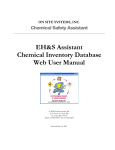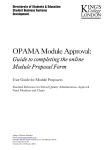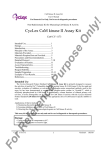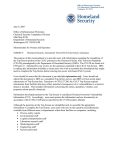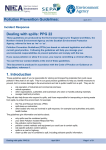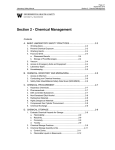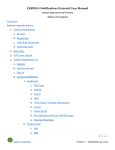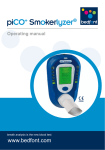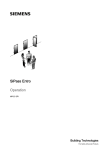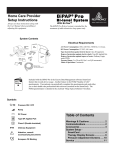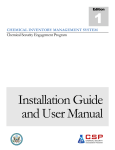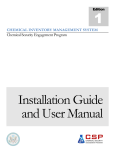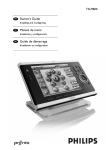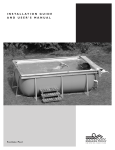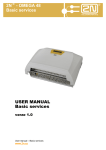Download Chemical Inventory Web User`s Manual
Transcript
ON SITE SYSTEMS, INC. Environmental Health & Safety Assistant EH&S Assistant Chemical Inventory Database Web User Manual (Revised 08/28/2009) © 2000 On Site Systems, Inc. 23 N. Gore Ave, Suite 200 St. Louis, MO 63119 Phone 314 963-9934 • Fax 314 963-9281 Medical College of Georgia Environmental Health & Safety Division 1405 Goss Lane, CI-1011 Augusta, Georgia 30912 Phone: 706-721-2663 Fax: 706-721-9844 ii Table of Contents INTRODUCTION Purpose of the Program Technical Support 1 1 1 GETTING STARTED Accessing the Program Changing Your Password Basic Navigation 2-4 2 3 4 MAIN MENU Access Choices Time-Out System 5 5 5 CHEMICAL INVENTORY Inventory Window: Viewing & Sorting Options Inventory Window Sorting Options Preview/Print Inventory Reports Preview/Print Chemical Fact Sheets Preview/Print Chemical Inventory Audit Report MSDS Search Adding & Editing Chemicals in Your Inventory Adding Chemical Window: Fields & Functions Editing or Deleting a Chemical in Your Inventory TRAINING 6-21 6 7-8 9 10 11 12 13 14-20 21 22 WASTE PICKUP Submitting a Request for Pickup Adding Waste Container Details Preview Print Waste Container Labels Accessing the Waste Labeling Systems from the Main Menu 23-29 23 24-27 28 29 ORDER FROM CHEMICAL STOCKROOM Introduction to the Chemical Exchange Program Submitting a Request for Pickup of Exchange Chemical Completing the Exchange Container Details Preview/Print Exchange Label View/Order from the List of Exchange Chemicals 30-33 30 31 31 32-33 33 REPORTS 34 PERMIT WORKER REGISTRATION 35 CONCLUSION 36 iii iv INTRODUCTION This manual does not attempt to explain how to use Windows components-dialog boxes, check boxes, pointers and cursors, list boxes and drop-down list boxes. All these are common to all Windows programs, and we’ve assumed you understand how to use them. Please refer to your Windows documentation for basic Windows training, or select Windows Tutorial from Program Manager’s Help Menu. The EH&S Chemical Inventory Database is firewall and password protected. It cannot be accessed from offcampus resources. It cannot be accessed without a designated login name and password. User access it limited. You will not be able to access or view any information other than your own. Purpose of the Program The Medical College of Georgia’s Environmental Health & Safety Division (EH&S) worked with On Site Systems Inc. to develop this software package to serve as a management and regulatory compliance tool. At our chemical user’s request, we included a Web based chemical inventory and waste management system, which was linked to a catalog of chemicals. The chemical catalog contains more than 13,500 chemicals with all of the physical, chemical, and regulatory information we could use to assist us in managing and tracking the chemicals from the time they arrive on campus until they are consumed in process or transported off site for disposal as a hazardous waste. Our chemical users can now update their chemical inventories, review critical chemical health, safety, and disposal information, request a pick up of the hazardous waste they produce, and print a “Hazardous Waste” label that is compliant with regulatory requirements using the Web application. The Chemical Inventory Database is designed to collect, store, maintain, and manage an avalanche of data for use in compiling information and reports for our chemical users, institutional decision makers, and federal, state, and local regulators. Technical Support Environmental Health & Safety Division help is available by: Phone: (706) 721-2663 Monday thru Friday 8:00 am – 5:00 pm CST Fax: (706) 721-9844 Email: [email protected] Division of Information Technology Support and Services help is available by: Phone: (706) 721-4000 Monday thru Friday 8:00 am – 5:00 pm CST Fax: (706) 721-7296 Email: [email protected] 1 Getting Started All areas where chemicals are used and/or stored are expected to support and participate in regulatory compliance efforts, and use the Chemical Inventory software for updating their inventories and for completing hazardous waste collection and labeling operations. Access to the Program Access to the Chemical Safety Assistant Web Application is provided by the Chemical Safety Office. A link to the program is provided on the Environmental Health & Safety Division’s Chemical Safety Office web page at: http://www.mcg.edu/services/ehs/chemsafe/chemsafe.htm Click on “Chemical Inventory Database” The following screen will appear. This is your Chemical Safety Assistant login window: • • • Enter in your designated User Name. Hit Tab and type in your designated Password. Then click on [LOGIN]. This will log you onto the system. Please contact the Chemical Safety Office if you have not been assigned a User ID and initial Password. Dolly Hobbs, Hazardous Materials Technician Phone: (706) 721-2663 Monday thru Friday 8:30 am – 5:00 pm CST Fax: (706) 721-9844 Email: [email protected] 2 Changing Your Password After receiving your access password from the Chemical Safety Office, you should use the password to login and set your password to something you can remember. Your password requirements for this program are the same as with all MCG software. Password Requirements 1. Must be at least 8 characters in length, 2. Must contain at least one number (or one letter if you use all numbers). 3. Must not be shared with anyone else. How to Change Your Password 1. At the login window, Type in your designated User Name. 2. Tab to the next field and type in your designated Password. 3. Click on [Change Password]. 4. In the next window Type in your New Password, tab to the next field, type in the New Password again to Confirm, then Click on OK. 5. When the login window re-appears, type in your New Password and Click on [Login]. The next screen to appear will be the Main Menu. 3 Basic Navigation The Web Browser menu bar does not function once you have opened the program. Basic Commands will be: 1. [ Main Menu ] to go back to the Main Menu for program module selection. 2. [<Back ] to go back to the previous window. 3. [Log Off] to exit the program 4. The above commands are all bold and in Red at the top of the window. Other Commands will be: 1. Words in “Blue” font color, sometimes underlined 2. An arrow at the right end of a field indicating pick list 3. Selection button, such as a radio button or check box where you will click to mark a selection, 4. Menu bar, or 5. A [?] to indicate a search engine following the respective field. 4 Main Menu When you have logged into the program, the first window you see is the Main Menu. The Main Menu allows controlled access to MCG’s Chemical Safety Assistant Web Applications. You have Six Choices that Perform the Following Functions 1. 2. 3. 4. 5. 6. Inventory – View, print, or update your Chemical Inventory and preview/print a Chemical Fact Sheet for each chemical in your inventory. Training – View your staff training records Waste Pickup – Request a chemical waste pickup from the Chemical Safety Office and produce a label for the waste container. Reports – View or print select reports Permit Worker Registration – Request to have a worker added to your lab Order from Chemical Stockroom– View list of Chemicals in Exchange Stockroom and request delivery for any item listed.. To Exit the program – Click on [Log Off] Time-Out System If you are not working in the program, you must [Log Off]. You may not leave the program running continuously. This program has a time-out system that will automatically shut down your connection when the program remains inactive for extended periods of time. Allowing the Time-Out function to activate may cause problems with your computer. This feature is part of the security systems. It is in your best interest to [Log Off] and close the program when it is not in use. 5 Chemical Inventory Inventory Window From the main menu, under CHEM click on Inventory. The Inventory Log screen will appear. The Web Browser commands do not function within the Chemical Program. Use the [Main Menu] to go back to the Main Menu where you have the program selection choices, [<BACK] to go back to the previous window, and [Log Off] to exit the Chemical Program. You have the following Inventory Viewing Options 1. 2. View Current Inventory Items Received/Ordered on (Date) Show All Items Chemicals by Description look-up Click on the Radio Button to the right of the item to select the view you would like to see. View Disposed Inventory Items Received/Ordered on (Date) Show All Items Chemicals by Description look-up Default is the Current Inventory. The inventory view selected will be displayed at the bottom of the screen 3. View Archived Inventory Items Received/Ordered on (Date) Show All Items Chemicals by Description look-up 4. Add Receipts – add a chemical to your inventory 5. Edit – edit the information for any chemical in your inventory 6 You have the following Inventory Sorting Options 1. Items Received/Ordered on – displays chemicals ordered/received on a specific date. 2. All Items – displays all chemicals listed in your inventory. Mark this item, and all of your chemicals are displayed at the bottom of the window. 3. Show me chemicals by Location – displays chemicals grouped by building and room number. 4. Show Chemicals by 1st Letter – allows you to view chemicals in alphabetical letter groups. 5. Show me Chemicals where” - This command is followed by two search parameter selection fields and a blank field. Using this option, you may display a specific chemical, or a group of chemicals that contain or start with the same parameter you enter. How to Execute the Sorting Commands 1. Click on “Items Received & Ordered on” and Enter a date. Then click on “Show” - This displays all chemicals ordered or received on a specific date. 2. Click on “All Items” - This will display all of the chemicals in your chemical inventory. 3. Click on “Show me Chemicals where” This command is followed by two search parameter selection fields and a blank field. a. In the first field you may select Chemical Description, CAS#, Catalog # or Chemical #. Chemical Description is the chemical name, CAS# is the Chemical Abstract Service Number, Catalog# is the Vendor Catalog Number – ignore this selection, we do not enter it as a primary indicator because of the multiple suppliers for campus labs. Chemical # is the file number for the Material Safety Data Sheet– do not use this as a search criteria. 7 b. In the next field you may choose Starts with, Contains, or Equals. These terms are self explanatory. c. In the Blank field, you will type your search parameter - Chemical Description (Chemical Name) or CAS # (include the hyphens when you type this in). d. When you have finished typing in one of the above search items, Click on “Show”. All of the chemicals in your inventory that fit your search parameters will appear at the bottom of the window. 4. Show Chemicals by Location, When you mark this option, a location selection field will appear. Click on the [?] to select the building/room location. 5. Show Chemicals by 1st letter, Click on the alphabet letter desired. 6. Sort by Column: Click on the column to sort your inventory by any column – one click for ascending, two clicks for descending. 8 Preview/Print Inventory Reports From the Inventory Window you may preview/print various formats of your chemical inventory provided in the reports list. There are currently three formats for viewing your chemical inventory. Additional formats may be presented. Suggestions are welcomed. Under [-Reports--] you have the following Inventory Reports: 1. Chemical Inventory by PI – inventory items are ordered by Inventory #. 2. Chemical Inventory by PI and Storage Location – inventory items are ordered by the storage location in your lab. 3. Chemical Inventory by PI and Building Lab Room – inventory items are grouped by building and Room number. To Preview/Print an Inventory Report 1. Click on the arrow to the right of [---Reports---] 2. Scroll up or down and click on the report name of the report you wish to run. 3. When the file download window appears, Click on [Open] to view the report. 4. When the report is displayed, you may execute “Print” or “Save As” under the “File” Command. Click on Report Name File>Save or File>Print Click Open 9 Preview/Print Chemical Fact Sheets From the Inventory Window you may preview/print a Chemical Fact Sheet for each chemical in your chemical inventory. The Chemical Fact Sheet contains all information that has been entered in the program’s Chemical Catalog. The information presented includes: chemical formula, molecular weight, chemical properties, health hazards, storage recommendations, hazardous waste properties, personal protection recommendations, and other information. It is not a Material Safety Data Sheet (MSDS). It is a summary of information from various resources. Material Safety Data Sheets are still maintained by the Chemical Safety Office, and are available upon request. To Preview/Print a Chemical Fact Sheet: 1. Click on the “All Items” to display all of the chemicals in your inventory. 2. Click on “Highlight” to mark the Chemical, 3. At the [--Reports--] field, Click on the arrow to the right of the field and scroll down to the report “Chemical Catalog Fact Sheet Highlighted Chemical” to run the report. 4. When the “File download” window will appears, Click on [Open] 5. When the Chemical Fact Sheet report appears, you may execute the “File> Print” or “File>Save” Command. If you would like to contribute to the Chemical Information provided in the Chemical Catalog, send a copy of the MSDS for the product to any member of the Chemical Safety Office, by e-mail, Fax: (1-9844) or by intra-campus mail (Chemical Safety Office – CI-1011). 10 Preview/Print Chemical Inventory Audit Report From the Inventory Window you may preview/print a Chemical Inventory Audit Report. This report contains all of the information provided to the Chemical Safety Office for Emergency Contact and Room Placarding at the top of the report. You should review this information for accuracy periodically, and forward any corrections to the Chemical Safety Office. Also included on the report is a list of all the chemicals in your inventory along with the quantity and amount in storage. You may use this for reviewing and updating your chemical inventory. At minimum, review and update your inventory twice a year – by June 30th and by December 31st of every calendar year. To Preview/Print a Chemical Fact Sheet: 1. Go to the [--Reports--] field, Click on the arrow to the right of the field and scroll down to the report “Chemical Audit “ to run the report. A “File download” window will appear when the report is ready. 2. Click on [Open] to view. You may execute the “Print” or “Save” under the “File” Command.. 3. The Chemical Audit Report can be use to review and update your chemical inventory and lab placard information. 4. At the top of the report, Principal Investigator information reflects current laboratory placard information. Contact the Chemical Safety Office to have this information updated as needed. 5. Below you will find a list of your chemicals grouped by room. You may use this to review and update your chemical inventory. 6. At minimum, you shall review and update your inventory twice a year – by June 30th and by December 31st of every year. 11 MSDS Search This application allows you to search for an MSDS on the Web without exiting the program. Clickon [ MSDS Search ] to the left of the chemical name in the inventory screen to search for a Material Safety Data Sheet (MSDS) without closing the program. The program activates the web browser and does an automatic search of the Sigma Web site for the MSDS using Google, and displays the search results. If the items displayed do not match your chemical, you may conduct a search for other chemical vendors who also manufacture and distribute the chemical using the Google Search engine. When you have finished your search and closed the web browser, you will return to the Inventory Screen. Hard copies of Material Safety Data Sheets (MSDS) are still available through the Chemical Safety Office (CSO). To request a copy of an MSDS, call the CSO at 1-2663. 12 Adding and Editing Chemicals in Your Inventory From the Inventory Window you may add, edit, or delete a chemical from your chemical inventory. The operations performed to Add or Edit a chemical in your inventory are very similar. 1. Click on [+Add Chemical+] to open the [Adding Chemical ] screen. 2. Click on [Select ] to the left of a chemical description/name to open the [ Editing Chemical ] screen. 3. Notice that the Adding Chemical Screen and the Editing Chemical Screen contain the same fields. The fields in both screens function exactly the same. Adding Editing 4. You may change any item in the Editing Chemical screen except the Inventory #. Inventory numbers are assigned by the database and are unique to every item in the inventory. 5. You may also remove a chemical from your Inventory through the Editing Chemical Screen. Click the checkbox in front of the words “Totally Disposed?”to mark the chemical, then Click on “Save/Return” to delete a chemical from your inventory. 6. All fields highlighted in Pink are required in both the Adding Chemical Screen and the Editing Chemical Screen. You must enter data in these fields in order to save. Fields that are not highlighted in pink are optional. 7. Using your Tab key will take you to each required field. If you would like to use the optional fields, click on the field. 8. Where the [ ? ] appears following a blank field, it indicates that a pick list or search engine is available for that field. Click on the question mark [ ? ] to activate the search engine or open the pick list. You will find the question mark following the Vendor, Lab, Chemical Description/Name, Storage Location, and Contact fields. For Vendor, Lab, Storage Location, and Contact, there is a pick list. For Chemical Description there is a search system. 9. When there is an arrow to the right of the field, there is a pick list attached to the field. Click on the arrow to select from the pick list. You will find the arrow in Volume/Size, Storage Device, and Date fields for Month and Day. In the Year field, highlight and type the number. 13 Adding & Editing Windows: Fields & Functions The Adding & Editing Windows contain the same fields which also function in the same manner. If you learn the fields and functions in one you are also learning the fields and functions in the other. The only difference between the two is access and contents. One window contains data, which you will edit. The other does not. Therefore, we are going to present the details of the [ Adding Chemical ] window in this next section. 1. Catalog # is the Vendor/Supplier Catalog or Product order number. This field is optional, except when you are using the “Not In Catalog” marker to load your chemical information. 2. CAS # is the Chemical Abstract Service number, which specifically identifies the chemical. This number can be found on the MSDS and is often printed on the original container label. The CAS # reads from right to left following the pattern, one number, hyphen, two numbers, hyphen, and several numbers. [Example: 7654-32-1] When you enter a CAS # in this field, the program will auto-search the Database Catalog for a corresponding chemical name and load it in the Chemical Description field 3. “Search Catalog” the Default item, “Search Catalog” is marked when you open the screen. When this is marked you must search for the chemical by clicking on the question mark [? ] to the right of the Chemical Description field. This opens an engine that allows you to search your “Personal Catalog” or the Database Catalog for the name of your chemical.. The Database Catalog currently contains information for over 13,000 chemicals, and is growing daily. 4. “Not in Catalog” was provided to allow users to continue loading their inventory item after they have conducted a search and determined that the product is not in the database catalog. When this is marked, you may by-pass the search load requirements, and type in the Chemical Description/Name, and it becomes mandatory for you to enter the Catalog # and the Vendor name. 5. Vendor This is the company or manufacturer you purchased the chemical from. Click on the [ ? ] to open a Vendor pick list. When the Vendor list opens, Click on Vendor Code or Vendor name to select. Use the scroll bar to the right of the screen to move up and down the list. If you do not see your vendor on the list, send an e-mail to [email protected] with the vendor information and a request to have it added. You will receive a reply when the request is accomplished. Note: If you mark the “Not in Catalog”, you must type in the full Chemical Name as it appears on the container or MSDS, and you must complete the “Catalog #” and “Vendor” fields in order to save your entry. When the “Search Catalog” is used the Catalog # and Vendor name are optional – you may enter them if you would like to do so, but they are not required. 14 6. Lab is the laboratory where the chemical is stored. This is a required field. You must select a lab for each chemical. Click the [?] to access the Lab selection pick list. Only your authorized labs will be displayed. If you do not see your lab on the lab selection list, contact EH&S Technical Support. (See page 3 for Support Information) a. When you click on [SELECT] the building and room number for the lab selected will auto-load into Adding Chemical lab field and the name of the building will auto-load in the following field. b. Note that [Last] follows the [ ? ] after the Lab field. If there are multiple chemicals to be added to the same lab, you may click [LAST] after you have entered and saved your first chemical, and the lab used for the previous entry will auto-load into the field. 7. Inventory# is automatically assigned by the CS Assistant program and is unique to each entry. Tab to the next required field. You may change any field in the Editing or Adding chemical Window, except the Inventory #. 8. PO# is your purchase order number – this is optional, you may use it or leave it blank. 15 9. Totally Disposed? When you no longer have a chemical and you wish to remove it from your inventory, Click on [Select] to the left of the item you wish to delete to open the Editing Chemical screen. Look for “Totally Disposed? And Click on the checkbox. Click on Save/Return. 10. “Chemical Description.” The “Chemical Description” is the name of the chemical. In this field you have two options: a. You may leave the default marker at “Search Catalog” and Click on the question mark [ ? ] following the Chemical Description field to activate a search engine to load the chemical name. b. Or, You may mark the “Not in Catalog”, When you mark this, Click on the blank field for Chemical Description and type in the Name of your chemical. Remember to enter Vendor & Catalog #. 11. You should always search for your chemical first. In order for chemical specific information to attach to your inventory item, it must be linked to the database Chemical Catalog. Adding a chemical to your inventory by selection using the search engine automatically attaches it to the catalog. 12. The “Not in Catalog” command was provided to allow a user to add a chemical to their inventory that was not found in the Database Catalog. If you must use this command, you will be required to provide enough information for the CSO staff to get a Vendor specific Material Safety Data Sheet (MSDS) for the item. The MSDS is used to load the chemical into the database catalog, classify the chemical according to EPA, DOT, and DHS guidelines, and to link the data to your inventory entry. 13. To search for the Chemical Description: Click on the [?] to the right of the Chemical Description field to activate the search system a. This program contains a database Chemical Catalog with more than 13,000 chemicals. The database Chemical Catalog is maintained by Chemical Safety Office Staff. b. It also produces a “Personal Chemical Catalog” which is a list of all the chemicals you have ever had in your Chemical inventory. Each time you add a chemical to your inventory, it is also added to your personal catalog. c. The Chemical Catalog in this database has the common chemical name and most synonyms by which a chemical may be known. When you search by chemical name in the database, you are searching a list that contains almost all possible names for the chemicals. 14. When you click on the question mark [ ? ], a search window will appear. 16 15. There are three search options available. You may use any one or combination of the three.. a. Show me Chemicals where Vendor is, b. Show me Chemicals where [Chemical Description, or CAS # [Starts with, Contains, or Equals], and c. Show me Chemicals that are in my “Personal Catalog”. 16. As long as the “Show me Chemicals that are in my Personal Catalog” is marked you will be searching your Personal Chemical Catalog. You may mark this and any of the two items to search your “Personal Catalog” by Vendor or by Show me Chemicals Where (Chemical Description or CAS#] is [Starts with, Contains, or Equal to]. a. If you have included the Vendor for each chemical in your inventory, you may search your “Personal Catalog” by specific vendor. Click on the box before “Show me Chemicals where Vendor is”, then Click on the arrow to the right of the blank field to pull up a pick list of vendors. b. To select the vendor, Click on the Vendor name. A list of chemicals for the vendor chosen will appear at the bottom of the screen. Click on the chemical name or CAS # to select the chemical. If you do not wish to search by vendor in your Personal Catalog, do not mark the “Show me Chemicals where Vendor is” selection. 17. To search outside of your “Personal Catalog”, you must unmark the Show me Chemicals that are in my "Personal Catalog" (previously received). Vendors are not included in the Database Catalog because several vendors may supply each chemical product.. Therefore, you must also unmark this selection. 18. “Show me Chemicals that are Appendix A Listed” is a list of chemicals identified by the Department of Homeland Security (DHS) as Chemicals of Interest with screening threshold quantities or STQs. This listing is set aside in the database to let users know that special requirements must be met to possess these chemicals. Any facility that possesses a chemical on this list, at or above the STQ for any of the applicable security issues, must register with the DHS using the online Chemical Security Analysis Tool (CSAT) and complete and submit an online report called “Top-Screen. DHS then uses this information to determine if the facility must meet any other requirements as listed under the CFATS regulation. The CSAT registration and Top-Screen Reports are completed by the Chemical Safety Officer. All chemicals under this listing must be reported to the Chemical Safety Office immediately. 17 19. “Show me Chemicals where” Mark this, and nothing else, to search the 13,294 chemicals that are presently in the database Chemical Catalog for the chemical you are adding to your inventory. Then do the following: a. In the first selection field you may search by [Chemical Description or CAS #]. The Chemical Description, is the chemical name, the CAS # is the Chemical Abstract Service Number. Catalog # is the vendor catalog number we do not enter this information into the database as a primary indicator because there are multiple suppliers for most chemicals. Chemical # is the MSDS file number, we do not expect you to know this number. Click on the arrow to the right of the field and select Chemical Description or CAS #. Description 19 b. In the second selection field you may select [Starts with, Contains, or Equals ] begin with the first option – “Starts with”. c. In the third field, which is blank, Type in the Chemical Name or CAS #, including the hyphens as you type (example: 7654-32-1), then d. Click on “Show”. The window will display all of the chemicals in the Catalog that match what you typed in the blank field. e. Double click on the [Chemical Name] or the CAS# to select the chemical you want. 20. The Adding Chemical screen will appear with the Chemical Name, CAS #, Chemical Formula, and to the next required field, or Click on the field you would like to fill. – Remember, if you have searched your “Personal Catalog” and the “Database Catalog” and you cannot find the chemical, Mark the entry as “Not in Catalog.” and type in the chemical name., and you must also enter the Vendor name and the Vendor’s catalog # before you can save your entry. 200 18 21. Physical State [Solid, Liquid, or Gas] you must mark one of these. Click the radio button to the left of the Physical State that matches your chemical. Tab to the next field. 22. The “# of Units” is the number of containers of the specific chemical. The default number is 1. To enter any number higher than 1, all of the containers must be the same size and same unit of measure. For example, if you have 2 containers of Methanol and they are all 1 liter in size, you may enter the number 2 in the “# of Units” field. If one container is 1 liter and the other is 500 mL, then you will have to enter the two containers separately. Type in the [#of Units] and Tab to the next field. 23. The “Quantity per Unit” the numerical amount for the container size. Type in the [Quantity per Unit] and Tab to the next field. 24. In the “Volume/Size” the unit of measure for the container, G=Grams, mg=Milligrams, etc. – click on the arrow to the right of the field to access the units pick list. 25. BOCA is an acronym for “Building Officials & Code Administrators” from the National Building Code regulation used in the construction and enforcement of school buildings. In this case, BOCA Amount is the total amount for the chemical calculated in pounds or gallons. The system automatically converts your units of measure to pounds or gallons when you Click the [Calc] following BOCA Amount. 26. [Storage Location] is the location of the chemical in your lab, this field is optional, you may use it if you’d like. To choose from a pick list click on the [?] following the field. Click on Select to choose the storage location. If you do not wish to use any of the pick list items, Click on Cancel at the top of the window. This will take you back to the Adding Chemical window. Click on the blank field and type in your location description. 27. Notice that [Last] follows the [? ]. When you have multiple entries, after you have saved your first entry, you may use this command to enter the last location previously saved. 19 28. [Storage Device] Storage Device has a pick list that is accessed by Clicking on the arrow to the right of the field, scroll down the list and click on the item of choice. 29. The [Chemical Formula] is part of the data entered in the database chemical catalog. It will automatically load when you enter the Chemical name from the Database catalog. 30. [Receipt Date] is a required field. The Default is the Current date. If you would like to change it, Click on the arrow to the right of the Month and Day or type in the month and day in the displayed format. The Default year is the current year. 31. Lbs/Gal Convert – is converted by the database when you enter the number of containers and container size and save, if the product is linked to the Database Catalog. 32. [Open Date] is an optional field, unless the chemical you are entering is a time sensitive material (peroxides and peroxide forming compounds). For these materials, you must enter a Date Opened. The calendar works the same as the Receipt Date. After you have entered a date, Click [Calc] for Expiration Date. The program will calculate an expiration date for you, based upon the time limit that the chemical can remain in storage. In addition, the inventory program is set up to notify you when a time sensitive material has expired and the CSO should be notified to pick it up for disposal. 33. [Order Date] is optional. You may use it or leave it blank. 34. [MSDS Location] all Material Safety Data Sheets are stored at Chemical Safety Office, Default location is loaded. 35. [Contact Name] is the laboratory contact. Click on the [ ? ] to the right of the field to select from a drop-down list. This is an optional field. 36. [Phone Number] is optional. Click on the field and type in the number. 37. Comments: use this to provide us with any additional information you think may help us to classify the product according to its health and safety risks, and to collect the MSDS for the item. 38. Click [SAVE & Add Another Chemical] to save and add another chemical without having to reload the lab. 39. Click on [Save/Return] to save the entry and return to the inventory screen. [Cancel] to cancel the operation. You will be returned to the current inventory display. 20 Editing or Deleting a Chemical in Your Inventory Everything in the Editing Chemical window appears and works the same as if you were adding a chemical to your inventory. 1. Click on [ Select ] in the inventory screen. 2. In the “Editing Chemical” - You may change anything in this window except the Inventory Number [Inventory #] and the Chemical Name. 3. All items highlighted in pink are required fields. You may change information in these fields, but you may not delete information and leave the field blank. 4. Fields that are not highlighted in pink are optional. 5. Using your Tab key will take you to each required field. 6. If you would like to change an optional fields, click on the field and type in your changes. 7. Multiple containers of a specific Chemical must be of the same Quantity per Unit and Volume/Size to be loaded as one entry. • For example: if you have four, 1 liter containers of methanol. You may enter 4 as the # of Units, 1 as the Quantity per Unit, and GL as Volume/Size. • If the containers are not the same, you must enter them separately. 8. Totally Disposed? – if the chemical has been consumed in process and you would like us to remove it from your inventory, Click in the box next to this command “Totally Disposed” to mark the chemical for removal. 9. Click on Save/Return at the bottom of the window to save your changes, 10. Click on Cancel if you do not want to save your changes. 11. You should update your Inventory at least twice a year – By January 1st and July 1st every year. 21 TRAINING This application only applies to training provided by sections under Environmental Health & Safety Divisions such as the Chemical Safety Office, Radiation Safety Office, or the Biological Safety Office. Through this application, the P.I. has access to his/her training history and the training history of any employee who works directly for him/her under him/her. Training history is entered by EH&S staff members. From the main menu, under CHEM click on Training. 1. The screen displayed is a listing of the Principal User logged-in and all workers attached to this user. 2. Click on the [VIEW] for the person that you would like to view training records for. 3. Training information consists of all classes complete. From the completed status future recurrent training requirements can be calculated by adding the course frequency to the training date. A listing of Training Due Dates is available under Reports. 4. Click [BACK] to exit this user records and select another worker. Click [MAIN MENU] to exit the training module. 22 WASTE PICKUP All Hazardous Chemical Waste must be processed through the Chemical Inventory Database for pickup. From the Main Menu, you will select the Waste Pickup application. Using this application, you will request a pickup of your hazardous chemical waste, provide the details of what is in your hazardous waste container, and produce a label to attach to the container. The label you produce will remain on the container from the time it leaves your laboratory, until it is recycled/reclaimed, treated/neutralized, or incinerated for disposal at a TSD facility. All containers offered for hazardous waste collection must have the “Hazardous Waste” label l attached. You will also have access to edit or delete existing waste pickup requests or enter a new waste pickup request through this application. From the main menu, under CHEM click on Waste Pickup Submitting a Request for Chemical Waste Pickup 1. Click on +Add Request+ to add a request for pickup chemical waste. 2. The P.I. code and name are inserted automatically. Request # [P070201013] is generated by the program, do not change this information. 3. Request Date: The Current date is inserted 4. Lab/Location: Click on [?] for a list of your labs. Click on [Select] to choose your lab. 5. Contact click on [?] to insert the name of the lab contact, or type in the name 6. Contact’s Phone type in the number. 7. Comments: Type in any information about the waste. You may use this to tell us where your waste will be located in the lab for pickup or if you need such supplies as Formalex or Charcoal.. 8. Campus: click on [ ? ] and select MCG 9. Waste Generator: click on [ ? ] and select MCG. 10. Click [SAVE] 23 Adding Waste Container Details In this window you will add the details for the waste you would like picked up. All of the information you enter in this window will be for one container. If you have more than one container of chemical waste, you will enter more than one detail for this request. The first field is Request #: [P070201013] , this number is selected by the database – do not change this number, Go to the next item. All question marks [ ? ] and arrows at the end of a field function in the same manner as identified. They will either activate a search engine or produce a drop-down pick list. Beginning at the top of the window the following information must be added for the waste: 1. Physical Form: (Gas, Solid, Liquid) Click on the radio button that applies 2. Total Quantity: the numerical amount for the container size, type in the number, and Tab to the next field. 3. Unit of Measure: the unit of measure for the container [Grams, Pounds, Milliliters, Click on the arrow to the right of the field,, Click on the unit that applies. 4. # of Containers this number is 1 [one],. You will enter a separate waste detail for each individual container. Note: All containers must be individually loaded into the “ Waste Detail,” section, with the only exception being flammable liquids. 5. Container Type, [plastic, glass, metal, etc.] Click on the arrow to the right of the field , click on the item that applies. 6. Empty Replacement Containers, if you need us to bring replacement containers when we pick up your waste, enter how many you want us to bring in this field. This field is Optional 7. Replacement Containers Description (if required) type in a description of the type container you would like us to bring ( example: one gallon plastic, one gallon glass, 2.5 gallon carboy, etc.). This field is Optional 8. Exchange Chemical ? Use this for Exchange Chemicals only. An Exchange Chemical is a chemical that is still in the original manufacture container, and still usable. If the chemical is not for exchange, leave the block unmarked and tab to the next field, 24 After you have entered the top part of the waste detail information, you will then enter the details about the chemicals that are in the container. All ingredients in the container must be identified along with the percent concentration for each. Searching for the Chemical Name 9. [Pick (?)...or Type Chemical -ORChoose an Inventory Item ->] The blank field below this statement is used to identify the name or names of the chemical(s) in the container. You must search for the Chemical name in your “Personal Inventory” or the Chemical Catalog.. Click on the [ ? ] at the end of the blank field to search for the chemical name. You absolutely must use the search engine to add chemical names to the details of your waste container – although the system will allow you to type a chemical name in the blank field, it will not link to the hazardous waste information necessary to identify and classify the waste and produce the appropriate container label 10. The search window that appears looks and functions exactly like the search window used when adding a chemical to your inventory. 11. You may search using more than one item. As long as the “Show me Chemicals that are in my “Personal Catalog” is marked, you will be viewing your personal catalog. Unmark this to search the Chemical Catalog in the database. 12. You may search by vendor, only if you have loaded vendor names into your inventory. Otherwise, do not mark “Show me Chemicals where Vendor is” – Vendors are not used as primary identifiers in the Database Chemical Catalog, 25 13. Mark the Show me Chemicals where [Chemical Description] [Starts with] to search for a specific chemical. a. [Chemical Description] will allow you to search by Chemical Description, or CAS # (ignore Catalog # and Chemical #, we do not include these as search options in the Chemical Catalog). Click on the arrow to the right in the field to change the selection to CAS #. b. [Starts with] leave this field as is. You can use[Starts with, Contains, or Equals], but these selections should only be used when you are not entirely sure of the correct name for the chemical. c. In the blank field that follows, type in the name of the chemical [for the CAS #., include the hyphens [ - ]. Then Click on [Show] in the green box. A list of the chemicals that match your search criteria will appear at the bottom of the search window. d. Double click on the Chemical Description or the CAS number to select. The chemical name will appear in the 14. Inventory # Link: In this field you may link the chemical to your inventory, click on the [ ? ] after Inventory # Link. Your inventory will appear – click on the item you wish to link. Your inventory will be adjusted. Since we are looking at Par Values for inventory items, unless you are removing the material from your inventory entirely – Use this only when you want to remove an item from your inventory. Otherwise, Do not mark the item - leave this field blank. 15. % Content remains at 100% if this is not a mixed waste. If it is a mixture, you must identify the percent content or concentration for each chemical in the container:. Calculate the approximate percentage. And type it in the box beneath % Content for each chemical in the mixture. This information does not have to be precisely accurate, unless the chemical is Highly Toxic, Extremely Hazardous. However, it does have to be close enough in approximation for CSO staff to determine how to handle the waste. The total in the lower left corner should equal 100%, therefore you should include Inert, or Nonhazardous materials such as Water when identifying the contents of a mixture. 26 16. Click [Attach] to incorporate the information you just entered. The information will appear in the grid below. Click on detach if you need to remove an item. Repeat steps 1 through 8 for any additional chemicals in the container. Again, you must perform the search to link all chemicals to the waste information. 17. Click [Submit]. You will see “Add Another Container” appear. There should be one waste detail for each waste container you want picked up. If you need to add more waste containers – click in this button, a blank detail screen will appear with only the Request # field filled. Enter the information for the next container. Just as you did for the first. 18. When you have finished loading the last item of container details, click on Submit, then Exit. 19. The Waste Request screen will appear. 20. Click on View to open the Waste Detail Window. Here you will see the list of container details you have entered for pickup. Notice the History # column – each container entry has a number. 21. From the Request Detail window, you may: a. Add another container by clicking on +Add+ Request Detail, b. Edit a detail by clicking on Edit to the left of the item you wish to change, c. Delete a detail by clicking on Delete, d. Or Print Hazardous Waste Container Labels for all entries. Items in the Waste Pickup window will remain there until a Chemical Safety Office Staff member transfers it to the waste files which are not accessible to campus users. 27 Preview/Print Hazardous Waste Container Labels You will print your Hazardous Waste Container Labels in the Request Details window. 1. In the Request Detail window, Click on Reports in the last column to the right. 2. A small window will appear with a list of label choices. • • • • Avery 8163 – 10 up - 2“ x 4”, ten per page Avery 5164 – 6 up – 3.3” x 4”, six per page Avery 5124 – 2 up – 5” x 8”, two per page Chemical Exchange Avery 8163 – same size as the 10 up label, only to be used for exchange chemicals 10 up is a small label, use this when you have no more than two chemicals in the container. 6 up is a bit larger, use this when you have no more than 6 chemicals in the mixture. 2 up is ½ page – use this when you have more than 6 chemicals in the mixture. 3. You may print the labels on a plain sheet of paper or use label sizes that correspond with the Avery label numbers above. To select an Avery Label size, Scroll down the list and Click on the label of choice. You will be asked what label do you wish to print 4. When using labels, you will use this to identify which label you want to print to – label position numbering begins at the top of the left column, goes down to the bottom of that column. 5. Position 1 is the first label at the top of the left column, then 2, and so on. Start with position 1 by typing in the number 1 and Click on OK. 6. When the window appears asking you if you wish to open or save the file, Click on Open. 7. Using the file menu at the top, select File,> Print to print the label. 8. If the container of chemical waste is small, you may put the container in a secondary container, such as a plastic bag, plastic bottle, etc., and attach the label to the secondary container. 9. As long as your request appears in the Waste Pickup Request Main Menu, you may produce a label. 28 Accessing the Waste Labeling systems from the Main Menu Click on Waste Pickup In the Add Request window Click on View to the right of the Request #, 1. When the Add Request Detail window appears, Click on Reports in the last column to produce a label. 2. Click on Main Menu or <BACK at the top of the window to exit the Waste Pickup Request application. 3. The steps involved in editing or viewing an existing request are identical to adding a request. 4. To Exit the program Click on Log Off at the top of the window. 5. If you are not working in the program, you must Log Off. You may not leave the program running continuously. This program has a time-out system that will automatically shut down your connection when the program remains inactive for extended periods of time. Allowing the program to remain open continuously would compromise the security of the system, and allowing the Time-Out function to activate may cause your computer to lock up. It is in your best interest to Log Off and close the program when you are not using it. Waste Pickup Request items will remain on the list until the CSO has picked up the chemical waste and removed it from the list. 29 ORDER FROM CHEMICAL STOCKROOM Introduction to the Chemical Exchange Program The Chemical Exchange Program was developed and implemented in response to the Environmental Protection Agency (EPA) requirement for hazardous waste minimization and pollution prevention as described in the Resource Conservation and Recovery Act (RCRA), and as amended by the Hazardous and Solid Waste Amendments of 1984. It is managed by Chemical Safety Office (CSO), under the leadership of James S. Davis, PhD, CHP, Associate Vice President of Environmental Health & Safety Division (EH&S) at MCG. Kenneth Erondu, the Chemical Safety Officer, Right-to-Know Coordinator, and Manager of the Chemical Safety Office, supervises CSO staff members who collect unwanted usable chemicals from various laboratories, store them in a central location for redistribution to other campus laboratories. A list of the chemicals available through the Exchange Program was published quarterly in the EH&S Newsletter. As an improvement to the program, EH&S has made Exchange Inventory available through the EHSA Chemical Inventory Database. From the Main Menu. Exchange Chemicals are still offered through the Waste Pickup systems. The Exchange Inventory can now be viewed by selecting the “Order from Chemical Stockroom” option at the Main Menu. Chemical users can also order any item listed in the Exchange inventory. CSO staff member will deliver all order items to the laboratory. The Exchange stockroom list is available to all chemical users who have access to the program. 30 Submitting a Request for Pickup of an Exchange Chemical From the Main Menu, Click on Waste Pickup. 1. Complete the Request for Pickup window just as you would if you were requesting a pick up of chemical waste. 2. Enter a separate Waste Pickup Request for Exchange Chemicals. Do not enter waste and exchange chemicals in the same pickup request. If you have a waste that needs to be picked up and an exchange chemical to offer, you should enter two separate requests for pickup – one request for the chemical waste, and another request for the exchange chemicals. 3. After entering the request information, Click on Save. The “Request Detail” window will appear. Completing the Exchange Chemical Container Details Complete everything in the Request Detail window, just as you would for a waste container, with one exception: You will mark the request detail as an Exchange Chemical. To mark the entry: Click on the check box to the right of the words “Chemical Exchange?” to identify your entry as an exchange chemical. You may enter more than one exchange chemical on a request for pickup. There should be a detail for each container you wish to offer to the Exchange program. • After you have clicked on Submit for the first container details, you will see “Add Another Container” appear – click on this to enter another detail. • When you have finished entering the last container information, Click on Submit, and Exit. the Add Request Window will appear. 31 Preview/Print an Exchange Label To produce an Exchange label, you will have to go back to the Add Request Detail Window. Click on View to the left of the Request # . In the Request Detail window you may : 1. Add another detail by clicking on +Add+ Request Detail. 2. Edit any Detail you entered by clicking on Edit to the left of the item you wish to change. 3. Delete any Detail you entered by clicking on Delete. 4. Print an Exchange Chemical Container Label. Click on Report in the far right column to produce a container label for your exchange chemicals. Notice that Report follows each container detail that has been entered. It does not matter which Report you click on. The system will print a label for every container detail listed. When you click on Report, a label selection menu will appear. • • • • Avery 8163 – 10 up - 2“ x 4”, ten per page Avery 5164 – 6 up – 3.3” x 4”, six per page Avery 5124 – 2 up – 5” x 8”, two per page Chemical Exchange Avery 8163 – same size as the 10 up label, only to be used for exchange chemicals There is only one label choice for an Exchange Chemical container: Click on this item to select. A window will appear asking you: “What Label # would you like to start Printing on?” Enter the number 1 in the blank box, then Click on OK at the bottom of the screen. When the preview/print is ready a report box will appear When the Report box appears, Click on “Open” to view the labels. Use the Menu at the top of the Adobe screen, to print the report – Select File>Print. Print the labels on a sheet of plain paper, cut out each label, and tape them to the appropriate container 32 Each container must have its own label attached. When taping the Exchange label to a container – do not cover or damage the original container label. Exchange Chemicals are picked up on Wednesday. CSO staff members will transfer the exchange chemical from the pickup request to the Exchange Inventory. When offering a chemical for exchange, consider the following: 1. Is the chemical expired, 2. Is the integrity of the container is still good 3. The chemical is not a time sensitive, high hazard chemical, for example: • Methyl Methacrylate - Polymerization by internally formed Peroxides dispose within 12 month, • Diethyl Ether –Peroxide hazard dispose within 12 months, • Chloroform – forms phosgene gas in the head space above the liquid after opening dispose within 2 years • Formic Acid – decomposed into CO2 Carbon Dioxide causing the container to fail catastrophically, container may rupture explosively in storage, time limit 2 years. View/Order from the List of Exchange Chemicals All chemicals offered for exchange will be available for viewing and ordering under the “Order from Chemical Stockroom” option at the Main Menu. Click on this [ Order From Chemical Stockroom ] to view or order from the Exchange Inventory. To request a chemical from the listing, Click on the field where you see “0” and type in the number of containers you would like delivered, then click on “Place Order.” A CSO staff member will deliver the chemical to your lab, and transfer the item into your inventory. 33 REPORTS The Reports selection under the Main Menu is designed to provide specialized reports that may be of benefit to all Chemical Users. All reports added to this section will have view/print privileges. Click on the name of the report to preview in Adobe– pdf format. Use the Adobe menu to print the report or to save the report to your documents folder. Click on Exit Report Menu to return to the Main Menu, and Log Off to exit the program. Reports can be added to this section as requested. 34 PERMIT WORKER REGISTRATION The Permit Worker Registration application allows the Principal Investigator/PI to request to have a worker added to any one of his/her laboratories in the database. From the Main Menu, Click on the Permit Worker Registration to access this application. A worker list will appear. Click on Add New Worker to access the data window to enter your worker information. 1. In the worker information screen you are able to enter the worker’s First Name and Last Name by typing in the information. 2. ID Number is the worker’s TA# which is printed on the back of their MCG ID Badge. If the worker does not have a TA#, enter the last five digits of their Social Security Number. 3. In the ID Type field, click on the [ ? ] to access a pick list. Scroll down the list, Double Click on the type that best describes your worker. 4. Email address, Fax, and Campus Box are optional. Work Phone is in most cases the lab phone number . 5. Department Code is a code for your depatment. Click on the [ ? ] to access a pick list for your department. Double Click on your Department’s Name to select. Department Name will auto-load when you select your department code. 6. At the bottom of the window you may enter the Supervisor and the Training courses your worker has received. Click on the [ ? ] to access a pick list for these items. After you have entered all of your worker’s information, 7. Click on [Submit] at the bottom of the window. 8. To remove a worker – email a request to any Chemical Safety Office Staff member. 35 CONCLUSION Under Federal, state, and local rules and regulations, all facilities that use or store hazardous chemicals must collect, store, and maintain an inventory for those chemicals. In conjunction, they must submit an inventory report to specific state agencies on January 1st and July 1st of every year. In an effort to meet this requirement, the Chemical Safety Office has developed a Web based chemical inventory database. This database is used to collect, store, and maintain an avalanche of data, and to compile reports from the data collected for institutional decision makers and federal, state, and local regulators. The institutional information, chemical data, user access and security systems are maintained by a CSO staff member who serves as the database administrator. Principal Investigators will be asked to maintain current inventories, with a minimum of semi-annual updates. Updates are to be completed at least thirty days prior to the report dates listed above, through the CSA Web chemical inventory database. Principal Investigators will determine which individuals in their lab will have access to their information in the HPA Chemical Assistant Web Program. If you experience problems with the CS Assistant Web software, contact the Chemical Safety Office for assistance at: Phone: (706) 721-2663 Monday thru Friday 8:00 am – 5:00 pm CST Fax: (706) 721-9844 Email: [email protected] For problems associated with your computer or file server, contact the Division of Information Technology Support and Services for assistance at: Phone: (706) 721-4000 Monday thru Friday 8:00 am – 5:00 pm CST Fax: (706) 721-7296 Email: [email protected] 36








































